Finance and Budget Management: Detailed Solutions and Analysis
VerifiedAdded on 2023/06/18
|21
|5563
|190
Homework Assignment
AI Summary
This document provides comprehensive solutions to a finance and budget management assignment, covering a wide range of topics from basic budgeting principles to advanced financial analysis. The assignment is divided into multiple sections, addressing key concepts such as budget types, financial viability, budget control, resource allocation, and deviation analysis. It includes detailed explanations of trend analysis, cost assessment, and strategies for managing payroll and accounts payable expenses. Furthermore, the document features a case study with practical tasks focusing on financial planning, variance analysis, and revenue improvement strategies. This resource offers students a thorough understanding of financial management and budgeting techniques, complete with practical examples and solutions.

MANAGING FINANCES
AND BUDGET
AND BUDGET
Paraphrase This Document
Need a fresh take? Get an instant paraphrase of this document with our AI Paraphraser
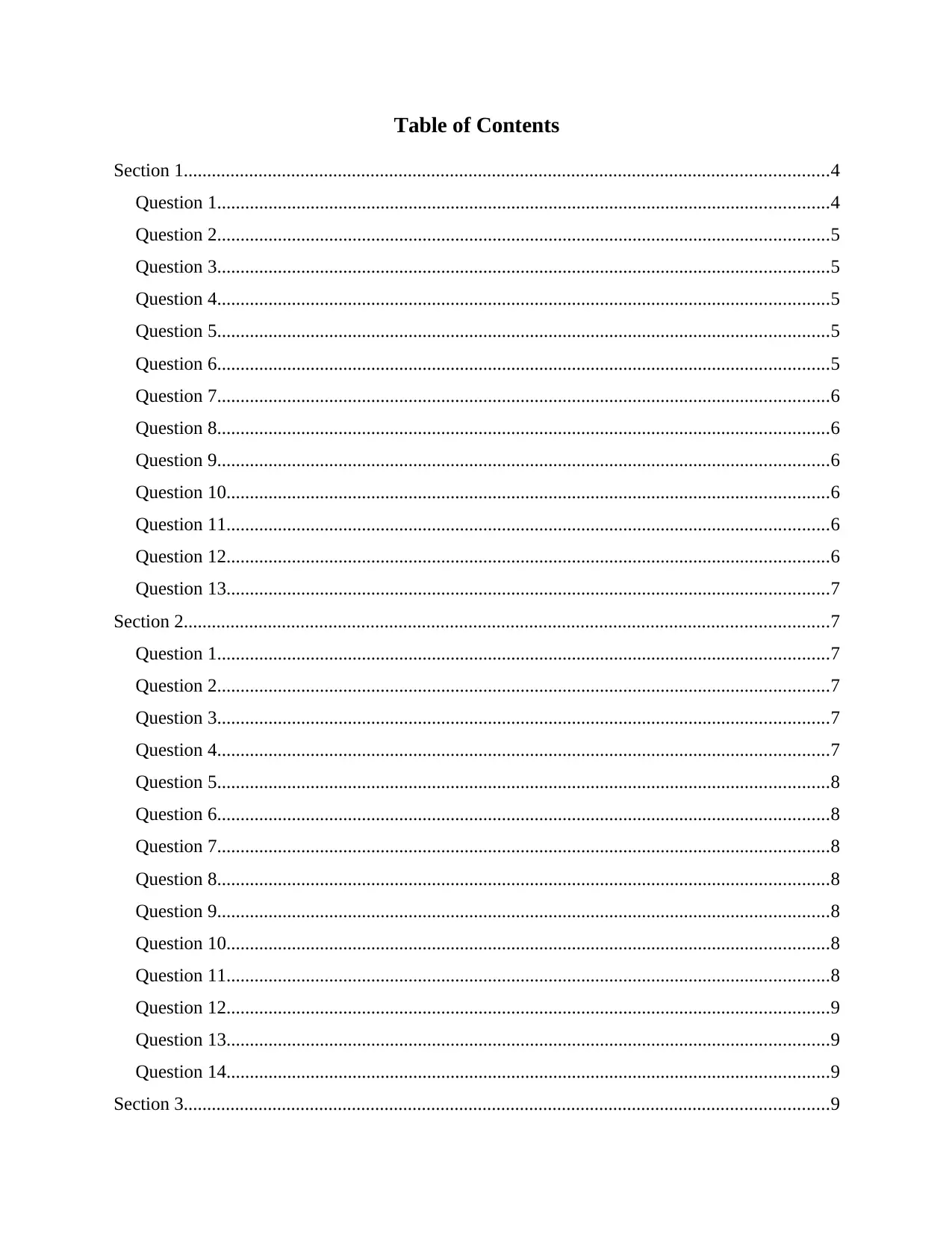
Table of Contents
Section 1..........................................................................................................................................4
Question 1...................................................................................................................................4
Question 2...................................................................................................................................5
Question 3...................................................................................................................................5
Question 4...................................................................................................................................5
Question 5...................................................................................................................................5
Question 6...................................................................................................................................5
Question 7...................................................................................................................................6
Question 8...................................................................................................................................6
Question 9...................................................................................................................................6
Question 10.................................................................................................................................6
Question 11.................................................................................................................................6
Question 12.................................................................................................................................6
Question 13.................................................................................................................................7
Section 2..........................................................................................................................................7
Question 1...................................................................................................................................7
Question 2...................................................................................................................................7
Question 3...................................................................................................................................7
Question 4...................................................................................................................................7
Question 5...................................................................................................................................8
Question 6...................................................................................................................................8
Question 7...................................................................................................................................8
Question 8...................................................................................................................................8
Question 9...................................................................................................................................8
Question 10.................................................................................................................................8
Question 11.................................................................................................................................8
Question 12.................................................................................................................................9
Question 13.................................................................................................................................9
Question 14.................................................................................................................................9
Section 3..........................................................................................................................................9
Section 1..........................................................................................................................................4
Question 1...................................................................................................................................4
Question 2...................................................................................................................................5
Question 3...................................................................................................................................5
Question 4...................................................................................................................................5
Question 5...................................................................................................................................5
Question 6...................................................................................................................................5
Question 7...................................................................................................................................6
Question 8...................................................................................................................................6
Question 9...................................................................................................................................6
Question 10.................................................................................................................................6
Question 11.................................................................................................................................6
Question 12.................................................................................................................................6
Question 13.................................................................................................................................7
Section 2..........................................................................................................................................7
Question 1...................................................................................................................................7
Question 2...................................................................................................................................7
Question 3...................................................................................................................................7
Question 4...................................................................................................................................7
Question 5...................................................................................................................................8
Question 6...................................................................................................................................8
Question 7...................................................................................................................................8
Question 8...................................................................................................................................8
Question 9...................................................................................................................................8
Question 10.................................................................................................................................8
Question 11.................................................................................................................................8
Question 12.................................................................................................................................9
Question 13.................................................................................................................................9
Question 14.................................................................................................................................9
Section 3..........................................................................................................................................9

Question 1...................................................................................................................................9
Question 2.................................................................................................................................10
Question 3.................................................................................................................................10
Question 4.................................................................................................................................10
Question 5.................................................................................................................................10
Question 6.................................................................................................................................10
Question 7.................................................................................................................................11
Question 8.................................................................................................................................12
Question 9.................................................................................................................................12
Question 10...............................................................................................................................12
Question 11...............................................................................................................................12
Section 4........................................................................................................................................13
Question 1.................................................................................................................................13
Question 2.................................................................................................................................13
Question 3.................................................................................................................................14
Question 4.................................................................................................................................14
Question 5.................................................................................................................................14
Case study part...............................................................................................................................14
Task 1............................................................................................................................................14
Question 1.................................................................................................................................14
Question 2.................................................................................................................................15
Question 3.................................................................................................................................15
Question 4.................................................................................................................................15
Question 5.................................................................................................................................16
Task 2............................................................................................................................................16
Task 3............................................................................................................................................17
Question 1.................................................................................................................................17
Question 2.................................................................................................................................17
Question 3.................................................................................................................................18
Question 4.................................................................................................................................18
Question 5.................................................................................................................................18
Question 2.................................................................................................................................10
Question 3.................................................................................................................................10
Question 4.................................................................................................................................10
Question 5.................................................................................................................................10
Question 6.................................................................................................................................10
Question 7.................................................................................................................................11
Question 8.................................................................................................................................12
Question 9.................................................................................................................................12
Question 10...............................................................................................................................12
Question 11...............................................................................................................................12
Section 4........................................................................................................................................13
Question 1.................................................................................................................................13
Question 2.................................................................................................................................13
Question 3.................................................................................................................................14
Question 4.................................................................................................................................14
Question 5.................................................................................................................................14
Case study part...............................................................................................................................14
Task 1............................................................................................................................................14
Question 1.................................................................................................................................14
Question 2.................................................................................................................................15
Question 3.................................................................................................................................15
Question 4.................................................................................................................................15
Question 5.................................................................................................................................16
Task 2............................................................................................................................................16
Task 3............................................................................................................................................17
Question 1.................................................................................................................................17
Question 2.................................................................................................................................17
Question 3.................................................................................................................................18
Question 4.................................................................................................................................18
Question 5.................................................................................................................................18
⊘ This is a preview!⊘
Do you want full access?
Subscribe today to unlock all pages.

Trusted by 1+ million students worldwide

REFERENCES..............................................................................................................................20
Paraphrase This Document
Need a fresh take? Get an instant paraphrase of this document with our AI Paraphraser
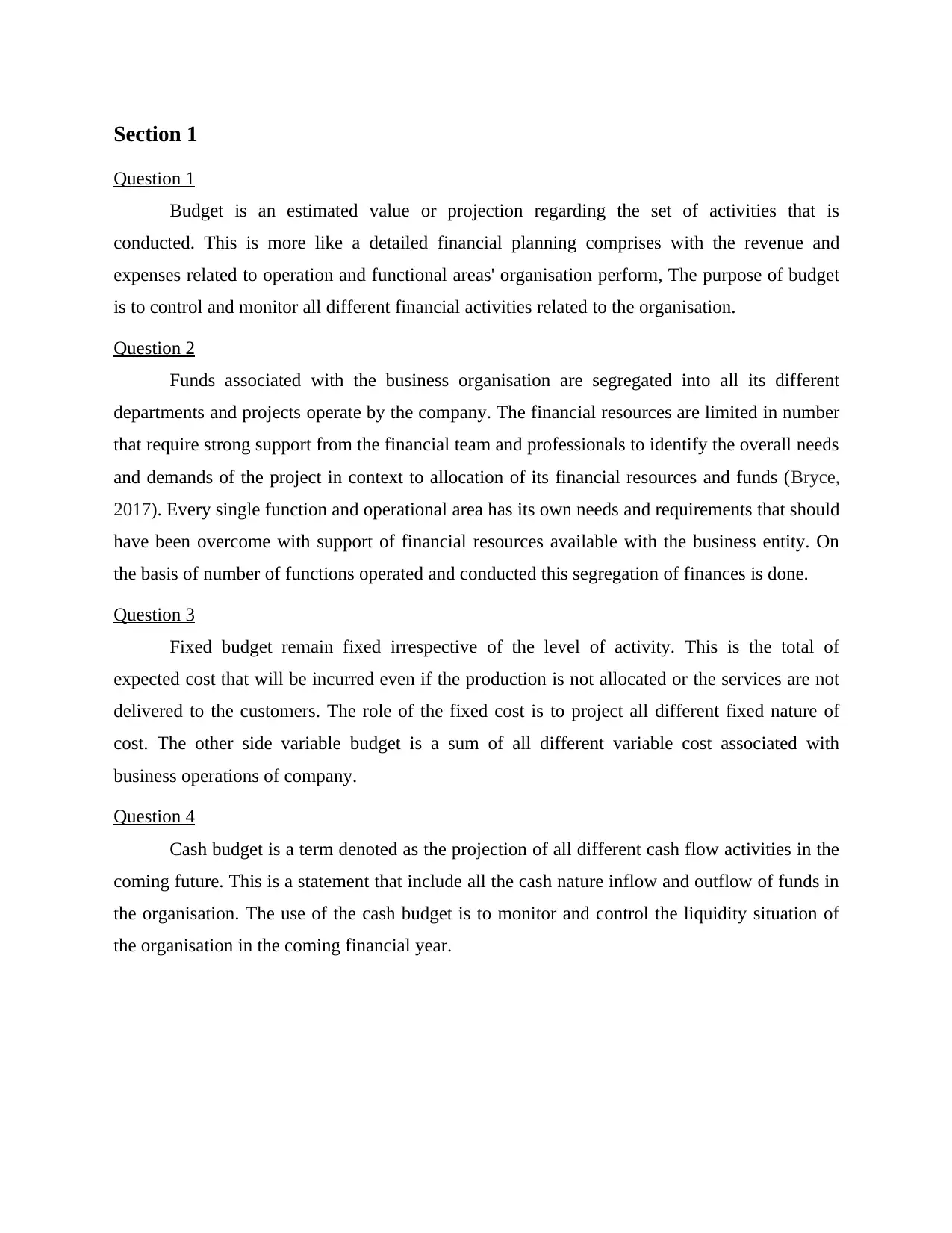
Section 1
Question 1
Budget is an estimated value or projection regarding the set of activities that is
conducted. This is more like a detailed financial planning comprises with the revenue and
expenses related to operation and functional areas' organisation perform, The purpose of budget
is to control and monitor all different financial activities related to the organisation.
Question 2
Funds associated with the business organisation are segregated into all its different
departments and projects operate by the company. The financial resources are limited in number
that require strong support from the financial team and professionals to identify the overall needs
and demands of the project in context to allocation of its financial resources and funds (Bryce,
2017). Every single function and operational area has its own needs and requirements that should
have been overcome with support of financial resources available with the business entity. On
the basis of number of functions operated and conducted this segregation of finances is done.
Question 3
Fixed budget remain fixed irrespective of the level of activity. This is the total of
expected cost that will be incurred even if the production is not allocated or the services are not
delivered to the customers. The role of the fixed cost is to project all different fixed nature of
cost. The other side variable budget is a sum of all different variable cost associated with
business operations of company.
Question 4
Cash budget is a term denoted as the projection of all different cash flow activities in the
coming future. This is a statement that include all the cash nature inflow and outflow of funds in
the organisation. The use of the cash budget is to monitor and control the liquidity situation of
the organisation in the coming financial year.
Question 1
Budget is an estimated value or projection regarding the set of activities that is
conducted. This is more like a detailed financial planning comprises with the revenue and
expenses related to operation and functional areas' organisation perform, The purpose of budget
is to control and monitor all different financial activities related to the organisation.
Question 2
Funds associated with the business organisation are segregated into all its different
departments and projects operate by the company. The financial resources are limited in number
that require strong support from the financial team and professionals to identify the overall needs
and demands of the project in context to allocation of its financial resources and funds (Bryce,
2017). Every single function and operational area has its own needs and requirements that should
have been overcome with support of financial resources available with the business entity. On
the basis of number of functions operated and conducted this segregation of finances is done.
Question 3
Fixed budget remain fixed irrespective of the level of activity. This is the total of
expected cost that will be incurred even if the production is not allocated or the services are not
delivered to the customers. The role of the fixed cost is to project all different fixed nature of
cost. The other side variable budget is a sum of all different variable cost associated with
business operations of company.
Question 4
Cash budget is a term denoted as the projection of all different cash flow activities in the
coming future. This is a statement that include all the cash nature inflow and outflow of funds in
the organisation. The use of the cash budget is to monitor and control the liquidity situation of
the organisation in the coming financial year.

Question 5
Profit and loss budget is a projection of expected future profitability and loss the
organisation wound entertain against the operational and functional activity conducted. This is a
budget that involve expected future profit and loss projection related to the organisation. This is
comprises with expected income and all expected expenses that company will incurred.
Question 6
Financial viability is a practice that involve the viability of the financial resources
associated with the organisation. This involves analysing the financial resources of the
organisation and also involve addressing the financial requirements of the organisation.
Profitability is a term that involve assessing the outcome of the business operation and function
that is conducted (Chanias, Myers and Hess, 2019). Liquidity is on the other side a term that
involve the position of the cash in the business. This involves where the organisation is capable
to mitigate its expenses and cash flow associated with the business organisation.
Question 7
Budget cycle is a tenure of budget. This is the overall time that is target against the
budget. Usually the budget cycle is of one financial year.
Question 8
Everly time budget priorities get change this also effect the budget. This further create an
impact over the areas of budget that will be affected. This involves making necessary changes in
the budget on the basis of the new and modified priorities. In this situation budget do not remain
the same it also alter based on the new and modified priorities.
Question 9
The financial experts and the board of directors of company are interested stakeholder
group that is interested in knowing about the wage related expenses in budget. The limitation of
funding in wages in always a part of the financial experts and also for the accountant.
Question 10
The awareness of budget control can be raised with support of email marketing. The
another practice that can be adopted in this regard is by conducting the social event. There are
the two main activities that is conducted to spread the awareness in respect to the budget
controlling process.
Profit and loss budget is a projection of expected future profitability and loss the
organisation wound entertain against the operational and functional activity conducted. This is a
budget that involve expected future profit and loss projection related to the organisation. This is
comprises with expected income and all expected expenses that company will incurred.
Question 6
Financial viability is a practice that involve the viability of the financial resources
associated with the organisation. This involves analysing the financial resources of the
organisation and also involve addressing the financial requirements of the organisation.
Profitability is a term that involve assessing the outcome of the business operation and function
that is conducted (Chanias, Myers and Hess, 2019). Liquidity is on the other side a term that
involve the position of the cash in the business. This involves where the organisation is capable
to mitigate its expenses and cash flow associated with the business organisation.
Question 7
Budget cycle is a tenure of budget. This is the overall time that is target against the
budget. Usually the budget cycle is of one financial year.
Question 8
Everly time budget priorities get change this also effect the budget. This further create an
impact over the areas of budget that will be affected. This involves making necessary changes in
the budget on the basis of the new and modified priorities. In this situation budget do not remain
the same it also alter based on the new and modified priorities.
Question 9
The financial experts and the board of directors of company are interested stakeholder
group that is interested in knowing about the wage related expenses in budget. The limitation of
funding in wages in always a part of the financial experts and also for the accountant.
Question 10
The awareness of budget control can be raised with support of email marketing. The
another practice that can be adopted in this regard is by conducting the social event. There are
the two main activities that is conducted to spread the awareness in respect to the budget
controlling process.
⊘ This is a preview!⊘
Do you want full access?
Subscribe today to unlock all pages.

Trusted by 1+ million students worldwide
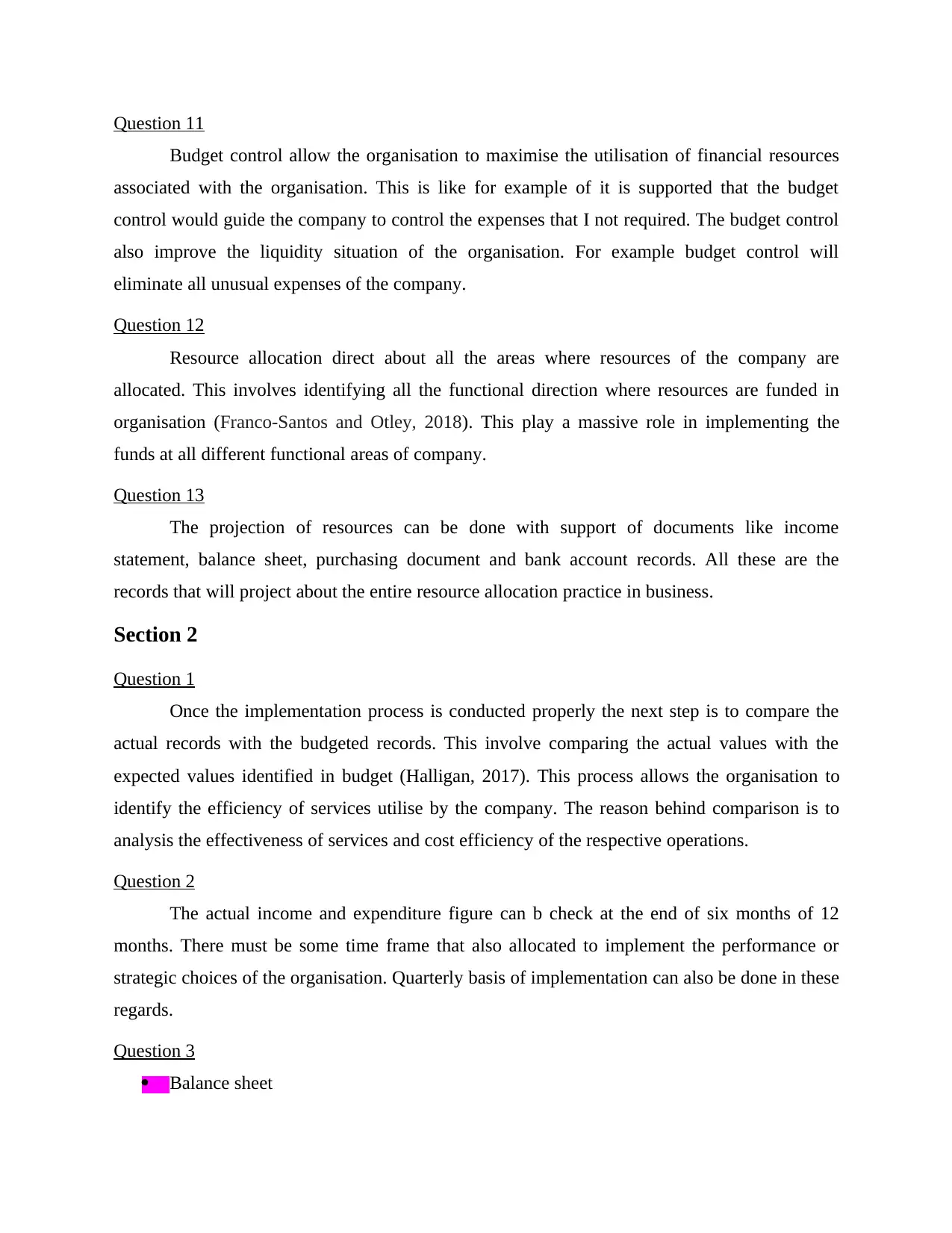
Question 11
Budget control allow the organisation to maximise the utilisation of financial resources
associated with the organisation. This is like for example of it is supported that the budget
control would guide the company to control the expenses that I not required. The budget control
also improve the liquidity situation of the organisation. For example budget control will
eliminate all unusual expenses of the company.
Question 12
Resource allocation direct about all the areas where resources of the company are
allocated. This involves identifying all the functional direction where resources are funded in
organisation (Franco‐Santos and Otley, 2018). This play a massive role in implementing the
funds at all different functional areas of company.
Question 13
The projection of resources can be done with support of documents like income
statement, balance sheet, purchasing document and bank account records. All these are the
records that will project about the entire resource allocation practice in business.
Section 2
Question 1
Once the implementation process is conducted properly the next step is to compare the
actual records with the budgeted records. This involve comparing the actual values with the
expected values identified in budget (Halligan, 2017). This process allows the organisation to
identify the efficiency of services utilise by the company. The reason behind comparison is to
analysis the effectiveness of services and cost efficiency of the respective operations.
Question 2
The actual income and expenditure figure can b check at the end of six months of 12
months. There must be some time frame that also allocated to implement the performance or
strategic choices of the organisation. Quarterly basis of implementation can also be done in these
regards.
Question 3
Balance sheet
Budget control allow the organisation to maximise the utilisation of financial resources
associated with the organisation. This is like for example of it is supported that the budget
control would guide the company to control the expenses that I not required. The budget control
also improve the liquidity situation of the organisation. For example budget control will
eliminate all unusual expenses of the company.
Question 12
Resource allocation direct about all the areas where resources of the company are
allocated. This involves identifying all the functional direction where resources are funded in
organisation (Franco‐Santos and Otley, 2018). This play a massive role in implementing the
funds at all different functional areas of company.
Question 13
The projection of resources can be done with support of documents like income
statement, balance sheet, purchasing document and bank account records. All these are the
records that will project about the entire resource allocation practice in business.
Section 2
Question 1
Once the implementation process is conducted properly the next step is to compare the
actual records with the budgeted records. This involve comparing the actual values with the
expected values identified in budget (Halligan, 2017). This process allows the organisation to
identify the efficiency of services utilise by the company. The reason behind comparison is to
analysis the effectiveness of services and cost efficiency of the respective operations.
Question 2
The actual income and expenditure figure can b check at the end of six months of 12
months. There must be some time frame that also allocated to implement the performance or
strategic choices of the organisation. Quarterly basis of implementation can also be done in these
regards.
Question 3
Balance sheet
Paraphrase This Document
Need a fresh take? Get an instant paraphrase of this document with our AI Paraphraser
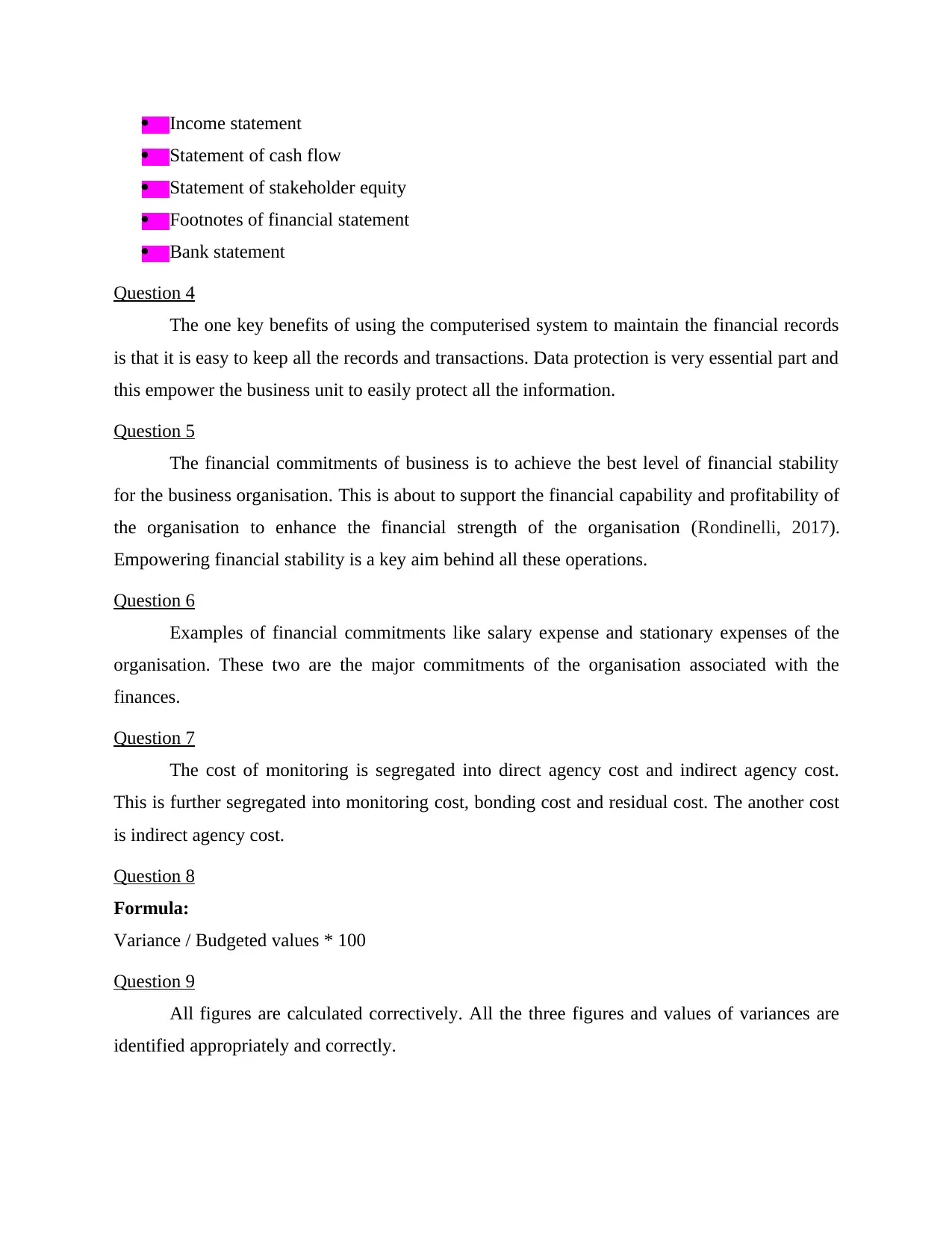
Income statement
Statement of cash flow
Statement of stakeholder equity
Footnotes of financial statement
Bank statement
Question 4
The one key benefits of using the computerised system to maintain the financial records
is that it is easy to keep all the records and transactions. Data protection is very essential part and
this empower the business unit to easily protect all the information.
Question 5
The financial commitments of business is to achieve the best level of financial stability
for the business organisation. This is about to support the financial capability and profitability of
the organisation to enhance the financial strength of the organisation (Rondinelli, 2017).
Empowering financial stability is a key aim behind all these operations.
Question 6
Examples of financial commitments like salary expense and stationary expenses of the
organisation. These two are the major commitments of the organisation associated with the
finances.
Question 7
The cost of monitoring is segregated into direct agency cost and indirect agency cost.
This is further segregated into monitoring cost, bonding cost and residual cost. The another cost
is indirect agency cost.
Question 8
Formula:
Variance / Budgeted values * 100
Question 9
All figures are calculated correctively. All the three figures and values of variances are
identified appropriately and correctly.
Statement of cash flow
Statement of stakeholder equity
Footnotes of financial statement
Bank statement
Question 4
The one key benefits of using the computerised system to maintain the financial records
is that it is easy to keep all the records and transactions. Data protection is very essential part and
this empower the business unit to easily protect all the information.
Question 5
The financial commitments of business is to achieve the best level of financial stability
for the business organisation. This is about to support the financial capability and profitability of
the organisation to enhance the financial strength of the organisation (Rondinelli, 2017).
Empowering financial stability is a key aim behind all these operations.
Question 6
Examples of financial commitments like salary expense and stationary expenses of the
organisation. These two are the major commitments of the organisation associated with the
finances.
Question 7
The cost of monitoring is segregated into direct agency cost and indirect agency cost.
This is further segregated into monitoring cost, bonding cost and residual cost. The another cost
is indirect agency cost.
Question 8
Formula:
Variance / Budgeted values * 100
Question 9
All figures are calculated correctively. All the three figures and values of variances are
identified appropriately and correctly.
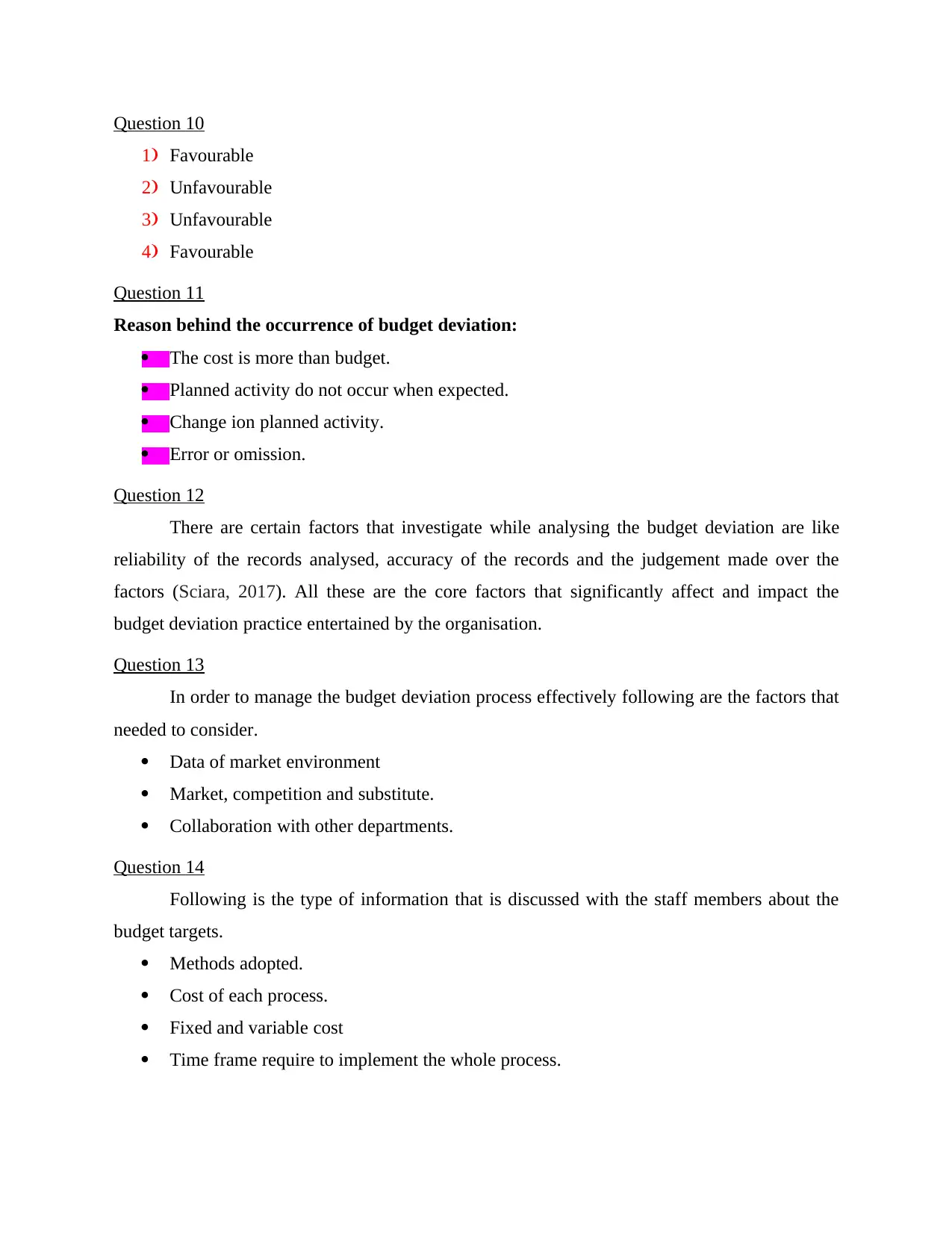
Question 10
1) Favourable
2) Unfavourable
3) Unfavourable
4) Favourable
Question 11
Reason behind the occurrence of budget deviation:
The cost is more than budget.
Planned activity do not occur when expected.
Change ion planned activity.
Error or omission.
Question 12
There are certain factors that investigate while analysing the budget deviation are like
reliability of the records analysed, accuracy of the records and the judgement made over the
factors (Sciara, 2017). All these are the core factors that significantly affect and impact the
budget deviation practice entertained by the organisation.
Question 13
In order to manage the budget deviation process effectively following are the factors that
needed to consider.
Data of market environment
Market, competition and substitute.
Collaboration with other departments.
Question 14
Following is the type of information that is discussed with the staff members about the
budget targets.
Methods adopted.
Cost of each process.
Fixed and variable cost
Time frame require to implement the whole process.
1) Favourable
2) Unfavourable
3) Unfavourable
4) Favourable
Question 11
Reason behind the occurrence of budget deviation:
The cost is more than budget.
Planned activity do not occur when expected.
Change ion planned activity.
Error or omission.
Question 12
There are certain factors that investigate while analysing the budget deviation are like
reliability of the records analysed, accuracy of the records and the judgement made over the
factors (Sciara, 2017). All these are the core factors that significantly affect and impact the
budget deviation practice entertained by the organisation.
Question 13
In order to manage the budget deviation process effectively following are the factors that
needed to consider.
Data of market environment
Market, competition and substitute.
Collaboration with other departments.
Question 14
Following is the type of information that is discussed with the staff members about the
budget targets.
Methods adopted.
Cost of each process.
Fixed and variable cost
Time frame require to implement the whole process.
⊘ This is a preview!⊘
Do you want full access?
Subscribe today to unlock all pages.

Trusted by 1+ million students worldwide
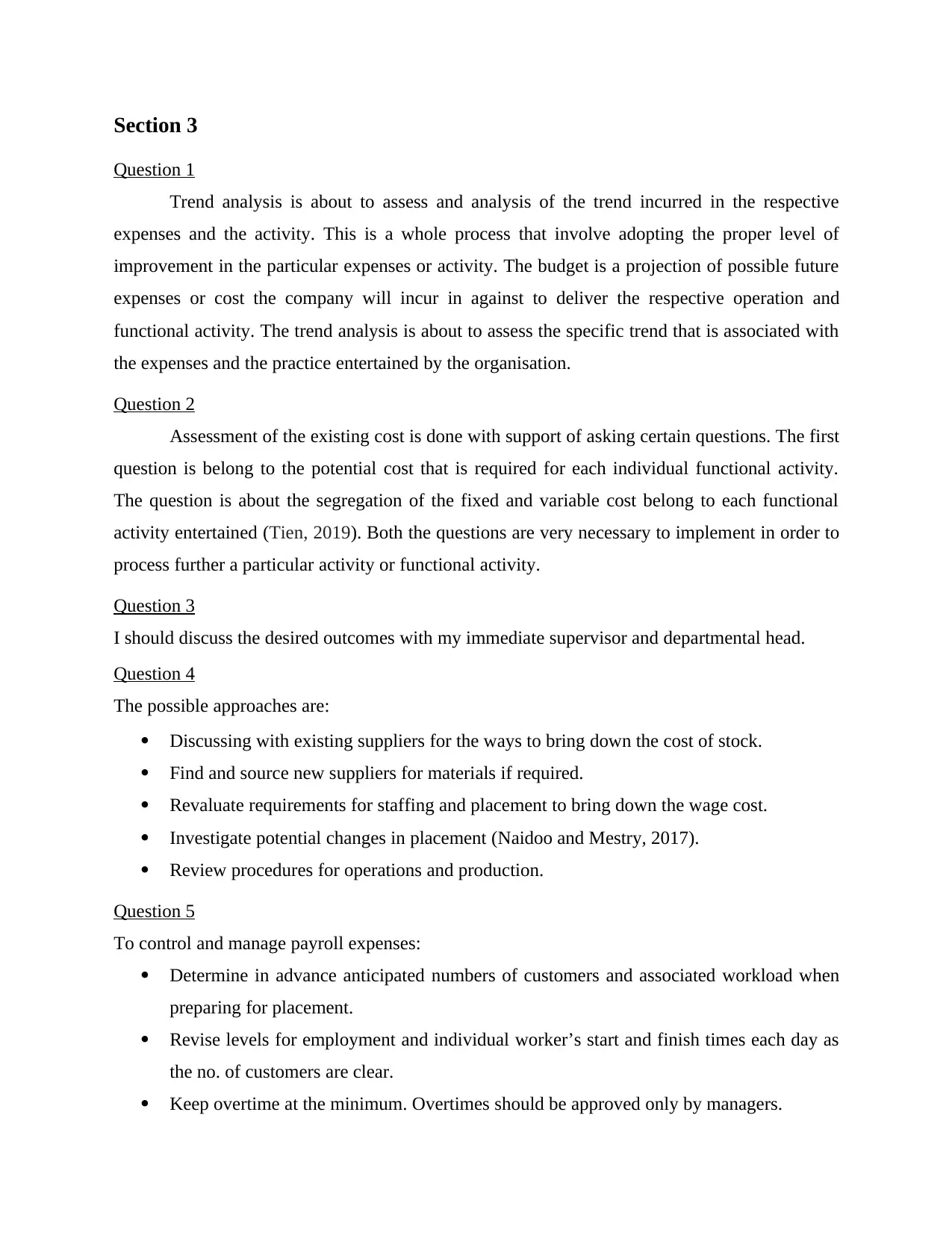
Section 3
Question 1
Trend analysis is about to assess and analysis of the trend incurred in the respective
expenses and the activity. This is a whole process that involve adopting the proper level of
improvement in the particular expenses or activity. The budget is a projection of possible future
expenses or cost the company will incur in against to deliver the respective operation and
functional activity. The trend analysis is about to assess the specific trend that is associated with
the expenses and the practice entertained by the organisation.
Question 2
Assessment of the existing cost is done with support of asking certain questions. The first
question is belong to the potential cost that is required for each individual functional activity.
The question is about the segregation of the fixed and variable cost belong to each functional
activity entertained (Tien, 2019). Both the questions are very necessary to implement in order to
process further a particular activity or functional activity.
Question 3
I should discuss the desired outcomes with my immediate supervisor and departmental head.
Question 4
The possible approaches are:
Discussing with existing suppliers for the ways to bring down the cost of stock.
Find and source new suppliers for materials if required.
Revaluate requirements for staffing and placement to bring down the wage cost.
Investigate potential changes in placement (Naidoo and Mestry, 2017).
Review procedures for operations and production.
Question 5
To control and manage payroll expenses:
Determine in advance anticipated numbers of customers and associated workload when
preparing for placement.
Revise levels for employment and individual worker’s start and finish times each day as
the no. of customers are clear.
Keep overtime at the minimum. Overtimes should be approved only by managers.
Question 1
Trend analysis is about to assess and analysis of the trend incurred in the respective
expenses and the activity. This is a whole process that involve adopting the proper level of
improvement in the particular expenses or activity. The budget is a projection of possible future
expenses or cost the company will incur in against to deliver the respective operation and
functional activity. The trend analysis is about to assess the specific trend that is associated with
the expenses and the practice entertained by the organisation.
Question 2
Assessment of the existing cost is done with support of asking certain questions. The first
question is belong to the potential cost that is required for each individual functional activity.
The question is about the segregation of the fixed and variable cost belong to each functional
activity entertained (Tien, 2019). Both the questions are very necessary to implement in order to
process further a particular activity or functional activity.
Question 3
I should discuss the desired outcomes with my immediate supervisor and departmental head.
Question 4
The possible approaches are:
Discussing with existing suppliers for the ways to bring down the cost of stock.
Find and source new suppliers for materials if required.
Revaluate requirements for staffing and placement to bring down the wage cost.
Investigate potential changes in placement (Naidoo and Mestry, 2017).
Review procedures for operations and production.
Question 5
To control and manage payroll expenses:
Determine in advance anticipated numbers of customers and associated workload when
preparing for placement.
Revise levels for employment and individual worker’s start and finish times each day as
the no. of customers are clear.
Keep overtime at the minimum. Overtimes should be approved only by managers.
Paraphrase This Document
Need a fresh take? Get an instant paraphrase of this document with our AI Paraphraser
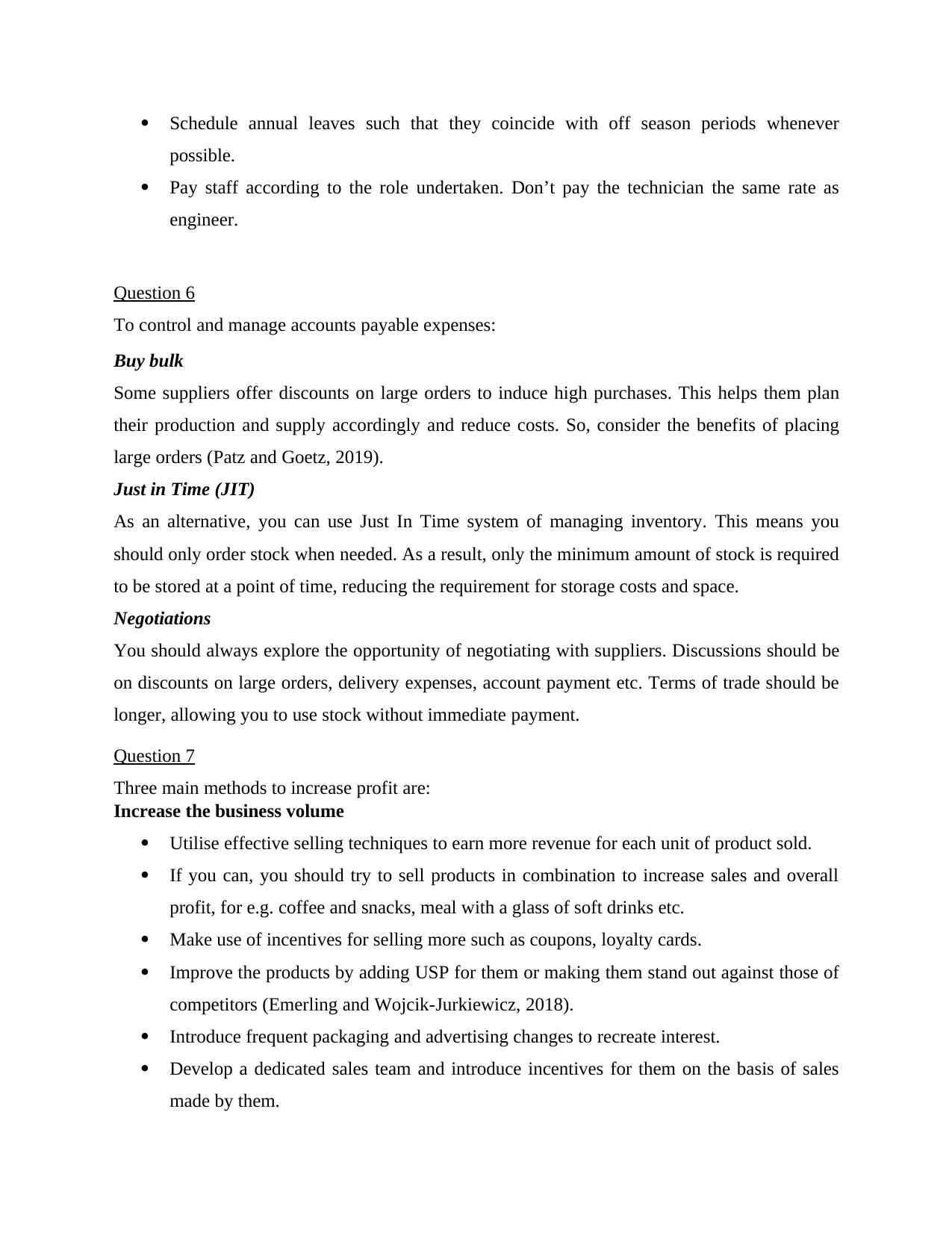
Schedule annual leaves such that they coincide with off season periods whenever
possible.
Pay staff according to the role undertaken. Don’t pay the technician the same rate as
engineer.
Question 6
To control and manage accounts payable expenses:
Buy bulk
Some suppliers offer discounts on large orders to induce high purchases. This helps them plan
their production and supply accordingly and reduce costs. So, consider the benefits of placing
large orders (Patz and Goetz, 2019).
Just in Time (JIT)
As an alternative, you can use Just In Time system of managing inventory. This means you
should only order stock when needed. As a result, only the minimum amount of stock is required
to be stored at a point of time, reducing the requirement for storage costs and space.
Negotiations
You should always explore the opportunity of negotiating with suppliers. Discussions should be
on discounts on large orders, delivery expenses, account payment etc. Terms of trade should be
longer, allowing you to use stock without immediate payment.
Question 7
Three main methods to increase profit are:
Increase the business volume
Utilise effective selling techniques to earn more revenue for each unit of product sold.
If you can, you should try to sell products in combination to increase sales and overall
profit, for e.g. coffee and snacks, meal with a glass of soft drinks etc.
Make use of incentives for selling more such as coupons, loyalty cards.
Improve the products by adding USP for them or making them stand out against those of
competitors (Emerling and Wojcik-Jurkiewicz, 2018).
Introduce frequent packaging and advertising changes to recreate interest.
Develop a dedicated sales team and introduce incentives for them on the basis of sales
made by them.
possible.
Pay staff according to the role undertaken. Don’t pay the technician the same rate as
engineer.
Question 6
To control and manage accounts payable expenses:
Buy bulk
Some suppliers offer discounts on large orders to induce high purchases. This helps them plan
their production and supply accordingly and reduce costs. So, consider the benefits of placing
large orders (Patz and Goetz, 2019).
Just in Time (JIT)
As an alternative, you can use Just In Time system of managing inventory. This means you
should only order stock when needed. As a result, only the minimum amount of stock is required
to be stored at a point of time, reducing the requirement for storage costs and space.
Negotiations
You should always explore the opportunity of negotiating with suppliers. Discussions should be
on discounts on large orders, delivery expenses, account payment etc. Terms of trade should be
longer, allowing you to use stock without immediate payment.
Question 7
Three main methods to increase profit are:
Increase the business volume
Utilise effective selling techniques to earn more revenue for each unit of product sold.
If you can, you should try to sell products in combination to increase sales and overall
profit, for e.g. coffee and snacks, meal with a glass of soft drinks etc.
Make use of incentives for selling more such as coupons, loyalty cards.
Improve the products by adding USP for them or making them stand out against those of
competitors (Emerling and Wojcik-Jurkiewicz, 2018).
Introduce frequent packaging and advertising changes to recreate interest.
Develop a dedicated sales team and introduce incentives for them on the basis of sales
made by them.

Increase production
Use the resources efficiently with productive placement, event planning, allocating
duties, and maintain records for bookings.
Purchase or lease an equipment which would enhance production speed or production
capacity, thereby enhancing efficiency.
Change pricing structures
You can increase the price of popular products or services, but you should ensure that
will be accepted by customers.
Moreover, the price increase should be incremental, not a large increase in one go.
Otherwise you risk losing even loyal customers.
Question 8
I should present my recommendations to the following two people:
General Manager- The person in charge of the entire business operations.
Finance Expert- Can be a finance manager, accountant or similar staff.
Question 9
Customer Support and Service
No business can afford to deteriorate their customer service. As a result of reduction in
services and staffing levels, poor service can lead to poor customer retention and
eventual loss of business. Business may see gain in the short term, but the long-term
results could be extremely negative (Smith, 2019).
Staff Morale
Employee Morale is not properly accounted for, while trying to improve the business
performance. However, unhappy employees may either don’t turn up or leave the
organisation altogether. Such employees don’t strive for the sales of services and
products as well as a staff that is keen and enthusiastic. The implementation of new
processes and systems might cut down expenses, but it can also cut down sales it the staff
don’t support the changes being implemented.
Use the resources efficiently with productive placement, event planning, allocating
duties, and maintain records for bookings.
Purchase or lease an equipment which would enhance production speed or production
capacity, thereby enhancing efficiency.
Change pricing structures
You can increase the price of popular products or services, but you should ensure that
will be accepted by customers.
Moreover, the price increase should be incremental, not a large increase in one go.
Otherwise you risk losing even loyal customers.
Question 8
I should present my recommendations to the following two people:
General Manager- The person in charge of the entire business operations.
Finance Expert- Can be a finance manager, accountant or similar staff.
Question 9
Customer Support and Service
No business can afford to deteriorate their customer service. As a result of reduction in
services and staffing levels, poor service can lead to poor customer retention and
eventual loss of business. Business may see gain in the short term, but the long-term
results could be extremely negative (Smith, 2019).
Staff Morale
Employee Morale is not properly accounted for, while trying to improve the business
performance. However, unhappy employees may either don’t turn up or leave the
organisation altogether. Such employees don’t strive for the sales of services and
products as well as a staff that is keen and enthusiastic. The implementation of new
processes and systems might cut down expenses, but it can also cut down sales it the staff
don’t support the changes being implemented.
⊘ This is a preview!⊘
Do you want full access?
Subscribe today to unlock all pages.

Trusted by 1+ million students worldwide
1 out of 21
Related Documents
Your All-in-One AI-Powered Toolkit for Academic Success.
+13062052269
info@desklib.com
Available 24*7 on WhatsApp / Email
![[object Object]](/_next/static/media/star-bottom.7253800d.svg)
Unlock your academic potential
Copyright © 2020–2025 A2Z Services. All Rights Reserved. Developed and managed by ZUCOL.





